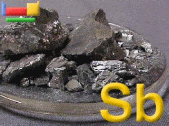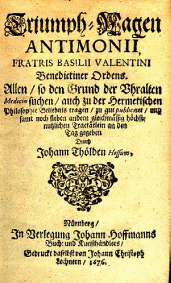Introduction
The importance of the periodic table of chemical elements cannot be overrated. Periodic table established the beginning of the contemporary phase of the development of Chemistry. With the discovery of the periodic table, the possibility of predicting new elements and describe their features became possible. The periodic table confirmed the most common laws of nature evolution, and opened a path for cognition of atomic structure.
Despite the popularity of the periodic table, ordinary people who are less familiar with the subject of Chemistry recognize only the most popular elements of it. Many elements, although being widely used, are left unrecognized. This paper takes the role of introducing one of such elements which is called Antimony. The paper analyzes its discovery and significance throughout history, as well as providing the biological importance and modern usage.
Overview
Antimony, [Lat. Antimoneum], is a semi-metallic chemical element, which “exists in two allotropic forms; the more common is silvery blue-white and has a rhombohedra crystalline structure.” (“Antimony”) This element has an interesting history, and interesting characteristics. As an element, it is essential not only for technology, but also for universal culture. Historians considers, that the first production of antimony occurred in the ancient East five thousand years ago. Antimony is mostly found with other elements and “Antimony was recognized in compounds by the ancients and was known as a metal at the beginning of the 17th century and possibly much earlier”.

History and Historical Significance
Antimony is known from ancient times. In eastern countries it was used approximately as early as 3000 years B.C. for making vessels. In ancient Egypt in the in the nineteenth century B.C. it was already used as form of cosmetics, where antimony trisulfide ( Sb2S3) was used as a paste to darken the eyebrows, lashes of eye perimeter.
In ancient Greece it was known as stimi and stibi from which came the name stibium and in 12-14 century B.C. the name antimonium replaced it. The Greek word stibi initially was related not to Antimony, but to its most important mineral antimony trisulfide. In ancient European countries this mineral was the only known. They learned how to smelt regulus antimony from it, which was considered as a semimetal. The famous European medieval metallurgist Agricola wrote that by the way of smelting, if a particular portion of Antimony is combined with lead, a typographical alloy, which is used in making fonts and printing books can be made. In such way, one of the main current applications of Antimony was found several centuries ago.
The characteristics and the methods of obtaining Antimony, its preparations and alloys were described in detail for the first time in Europe in the famous book “The Triumphal Chariot of Antimony” (Currus Triumphalis Antimonii) whose author entered the history of Chemistry by the name of Basilius Valentinus, allegedly lived in the beginning of the fifteenth century. However, in the last century, it was established, that among the Benedictines order there were no prior with such name. The scientists concluded that “Basilius Valentinus” was a pseudonym of unknown scientist, who wrote his treatise not until the middle of the sixteenth century.
It was back in medieval times when the metallurgists and chemists noticed that Antimony was forging worse than “classic metals” and thus along with bismuth, arsenic and zinc it was singled out in a special group – semimetals. This inclusion in such group was two-sided, as on the one hand, from the outer look, crystalline or grey, antimony is a typical metal with a grey-white color and light bluish shade, which gets stronger with more impurities. On the other hand, as opposed to most metals, it is very fragile and easily reduced to powder, and additionally considerably worse conducts electricity and heat. In chemical reactions Antimony also displays duality in chemical reactions, which does not allow to definitely answering the question of whether it is a metal or not. As an answer to such doubts molten Antimony dissolves almost all metals.
Antimony and Health
Many of the antimony’s compounds are toxic. Compounds of trivalent antimony are more toxic, than compounds of pentavalent antimony. Antimony was linked to many cases of poisoning, which can be differed in the dosage of antimony used. The reasons of excess of Antimony in human organism can be related to food (water) or medications. Additionally, “Recent in vitro studies have suggested a potential role for antimony as a confounder in human health studies related to arsenic in drinking water.” (McCarty et al.) Although the research conducted did not support these suggestions, the differences between laboratory and field conditions, the role of Antimony might still be in question, as “Sb and As are individually considered toxic to human health, and each is regulated in drinking water by the U.S. EPA.” (Mccarty et al.)
Another potentially dangerous threat found in Antimony that can be absorbed into water from their plastic containers. The research made by expert Dr William Shotyk, conducted tests that “found traces of antimony, a chemical used in the making of polyethylene terephthalate (PET) bottles, used by most mineral-water sellers.” (“The Poison Lurking in” 15) Small doses of antimony can result in illness and depression, whereas large doses can result in vomiting and even death. Although the amounts of antimony in plastic containers were below the recommended level, it was found out “that the levels almost doubled when the bottles were stored for three months.” (“The Poison Lurking in” 15)
However, there are many biological benefits for antimony as a component used in medicine. Antimony was used in therapy historically, and in 1907 it was rediscovered as antimony tartrate was discovered to be a potent trypanocide. Later intensive research produced a group of antimonials, the most important uses of which are treatment of bilharzias, tryponosomiasis, and kala-azar.

Modern Uses
Antimony due to its fragility is rarely used; however, because it increases the solidity of other metals like tin and lead, and it does not get deoxidized in normal conditions, antimony is often included in different compounds. The number of compounds in which Antimony is included is almost two hundred.
Antimony belongs to a number of few metals that are extending at hardening. Thanks to this property of antimony typographical metal fills well the forms when manufacturing typographic fonts; the lines that are casted from this metal give accurate prints. Antimony gives to typographical metal hardness, shock firmness and wear resistance. Metallic compounds of antimony with aluminum, gallium, and indium possess semi-conductor properties. Antimony improves the properties of one of the most important semiconductors – germanium. It can also be found in batteries, pigments, ceramics and glass.
Antimony is used also for electroluminescent lamps calcium halophosphate activation and Antimony radioactive isotope is used in gamma-radiation and neutron sources. Antimony compounds are applied in medicine and in various branches of national economy. They are used for the preparation of some types of glass, paints, rubber products etc. Antimony sulphide is applied in pyrotechnics, in manufacturing of matches, rubber vulcanization. Antimony Chloride of is applied to protect metals against corrosion. Metal antimony is a part of some compounds applied in manufacturing bearings. In medicine solusurminum and other antimony-based medications are used for treatment of leishmaniasis and some of helminthiasis (for instance schistosomiasis). In a word, antimony – one of the most ancient metals, known to mankind, and it is still essential for the world today.
Conclusion
It can be seen that many elements, despite being unknown for the masses, they are widely used, moreover some of their applications are known centuries ago. Antimony is certainly one of such elements, where some of its ancient usages such as cosmetics are still used in the Middle East. Such implementation of this element where it is used in technology at the same time combined with ancient traditions give this metal certain universality. It takes a quick look around to find various implementation of this element in everyday life, concluding that Antimony should get more credit as it really deserve it.
Works Cited
- “Antimony.” The Columbia Encyclopedia. 6th ed. 2007.
- Mccarty, Kathleen M., et al. “Antimony: An Unlikely Confounder in the Relationship between Well Water Arsenic and Health Outcomes in Bangladesh.” Environmental Health Perspectives 112.8 (2004): 809+.
- “The Poison Lurking in Your Plastic Water Bottle.” The Mail on Sunday (London, England) 2006: 15.
- “Antimony Applications.” Chemical-elements. 2006.
- “Antimony.” Kirk-Othmer Concise Encyclopedia of Chemical Technology. New York: Wiley-Interscience, 2007.
- “Antimony (Sb) – Occurrence, Extraction, Properties and Applications.” Azom. 2008. The “AZo Journal of Materials Online” Web.
- Mark Winter. “Antimony.” Web Elements. Web.